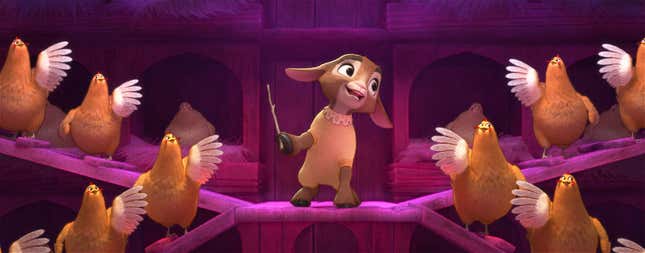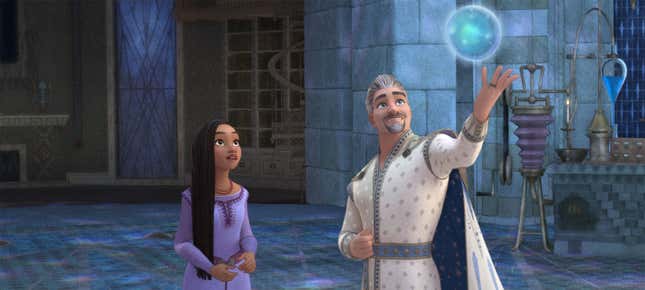Walt Disney Animation Studios’ 100 years of creating timeless magic is at the core of Wish, its latest feature now playing in theaters.
io9 recently sat down with Wish directors Fawn Veerasunthorn and Chris Buck to talk about the animation company’s effort to pay homage to everyone that came before and will continue Disney’s legacy, in a story that draws on the origins of the very wishes that brought the studio to life. The film, written by Jennifer Lee (Frozen) and Allison Moore, centers around Asha (Ariana DeBose) a young woman determined to find out why her people’s wishes are being safeguarded by their king (Chris Pine) instead of granted. She goes on an adventure with her friends and goat sidekick, Valentino (Alan Tudyk), when a star falls to Earth to help them gain free will over their destined desires.
Sabina Graves, io9: Congrats on the film, it’s breathtaking! It really encompasses what the Disney legacy is but also gives us new stories with a fantastic new heroine in Asha. How would you say that Wish represents both the first 100 years of Disney but also looks toward the future of the animation?
Fawn Veerasunthorn: That was the goal from the start: that we know we’re celebrating 100 years of Disney animation, but we know that if Walt [Disney] were to be alive today, he would want to make something new. So we balance out; we have a new fairy tale story, original story, original songs written by Julia Michaels and Ben Rice, contemporary tunes. And we also developed this stylization for animation that it’s a throwback to the beautiful watercolor of Snow White. And the design aesthetic of Sleeping Beauty.
io9: Yes! And I love how that CG watercolor style blended in seamlessly. I’m a big Paperman fan, so to see that kind of realm of fairytale energy return, I was so excited.
Chris Buck: Those shorts really helped us pave the way to be able to actually do a whole feature with this new technique.
io9: It’s been mentioned that when it came to a lot of the film’s style, Wish was influenced by the angles of Pinocchio and the wide shots in Sleeping Beauty. What was important for you to take from those original films and bring it into this story?
Buck: We studied the the camerawork and the layouts and everything from those films. There’s a real elegance to the camera work that we wanted to keep and maintain. Some of that was because of this multi-plane camera that they used to have and they’d be able to shoot these many levels and get this depth. But you’re only working with 2D; you wouldn’t be able to move around like we can now in its whole environment with the computer. There was still a desire to keep that elegance of those moves, so our layout team, our cinematographer, our art directors, they all got on board just to come up with this style. Hopefully you come out of the movie feeling like “gosh, it feels like one of the classic movies,” yet it still feels fresh and new.
io9: I definitely felt that way. I’m really a big fairytale Disney heroine fan and to see Asha encompass all of these gorgeous sort of thematics that we’ve seen throughout Disney’s legacy is so much fun. Let’s talk a bit about Ariana—you shared her movement was incredible in the booth. How that inform her design?
Veerasunthorn: Ariana brought so much to Asha’s movement because we record all the dialogue sessions and music sessions and animators go back and look at those. But not only that, Ariana being the collaborator that she is, she would talk to us about “I have all these ideas about how Asha would walk or run or move. Who do I talk to?” So we invited her to Disney Animation and she got to talk to the animators. And it was a big hit. They take so much inspiration because when you work in animation, you observe how a person behaves—that is kind of ingrained in our DNA.
io9: Speaking of size, Star is so adorable. You’ve said the heart-shaped face on Star is meant to look like Mickey’s face shape, which is such a fantastic Easter egg to represent Walt’s original wishes. What was it like to dig through all of the lore and select the important parts to incorporate into the film?
Buck: What was so much fun about this one was researching Walt and his life—and getting to know Walt even more. We didn’t know that he had a wishing tree on his farm. We didn’t know that he dressed up his farm animals in clothes. There were things that you certainly go back like, “Oh! This like the origin story of a lot of his stories and what he put into the movies.” So that was that was just so much fun going back and really getting to know Walt even better, and then putting more of that in the movie. Walt is such an inspiration for Asha’s character because as a character that won’t give up on her wish, on her dream—that’s exactly what Walt did. He never, never gave up. He was always striving to do something bigger and better and and bring more joy and hope to the world.
io9: I loved the meeting scene between Asha and Star and how Valentino even comes into play in that regard. Alan Tudyk having the deep voice is so hilarious. Did Alan see Valentino before creating the voice or was the voice always planned?

Veerasunthorn: We had the design of Valentino, he’s a cute goat in pajamas, right? So initially, Alan (Tudyk) played around with a higher-pitch voice, which was great. And then he went, “Let me play around” and he went into the sophisticated, deeper voice of a goat who knows everything and has so much to share that was just so funny.
Buck: Alan does so much great improv. You give him a few lines and he can he can go on and on and on and on. A lot of his lines in the movie have been sort of improv’d and Alan-ized.
Veerasunthorn: And the attitude of Valentino started to seep into the animation because initially he was kind of an innocent-looking goat. And paired with this fantastic voice, we started changing that to match.
Buck: He has much more of an attitude. And if you watched the film, the animators were very careful to keep that attitude of Valentino before he is given the gift of speech.
io9: The kingdom of Rosas exists way before some of the ones fans are more familiar with in Cinderella and Snow White. What was really important for you to honor and bring from the cultural heritage of the Iberian Peninsula, and mesh with our familiarity of Disney kingdoms?

Veerasunthorn: We know we want to hit the familiarity of the fairy tale look that we have done in the legacy of our films. But we also are aware that in this day and age, [with our] audience all around the world, we want to give them the point of connection. And the Iberian Peninsula, particularly the space between North Africa and Southern Europe in the Mediterranean Sea, seems like a perfect place to set a fictional island where we can have multiculturalism that is true to the cultures at the time. And we checked that with our cultural consultants that this is within reality. We take some liberties there with the percentage of people, but we hope that this will create a relatability to the modern audience.
Wish is out now in theaters.
Want more io9 news? Check out when to expect the latest Marvel, Star Wars, and Star Trek releases, what’s next for the DC Universe on film and TV, and everything you need to know about the future of Doctor Who.
Trending Products

Cooler Master MasterBox Q300L Micro-ATX Tower with Magnetic Design Dust Filter, Transparent Acrylic Side Panel, Adjustable I/O & Fully Ventilated Airflow, Black (MCB-Q300L-KANN-S00)

ASUS TUF Gaming GT301 ZAKU II Edition ATX mid-Tower Compact case with Tempered Glass Side Panel, Honeycomb Front Panel, 120mm Aura Addressable RGB Fan, Headphone Hanger,360mm Radiator, Gundam Edition

ASUS TUF Gaming GT501 Mid-Tower Computer Case for up to EATX Motherboards with USB 3.0 Front Panel Cases GT501/GRY/WITH Handle

be quiet! Pure Base 500DX ATX Mid Tower PC case | ARGB | 3 Pre-Installed Pure Wings 2 Fans | Tempered Glass Window | Black | BGW37

ASUS ROG Strix Helios GX601 White Edition RGB Mid-Tower Computer Case for ATX/EATX Motherboards with tempered glass, aluminum frame, GPU braces, 420mm radiator support and Aura Sync









